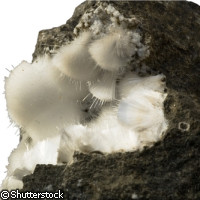Shedding new light on zeolites
The secrets of zeolite minerals are slowly giving themselves up thanks to the intense scrutiny of the European Synchrotron Radiation Facility (ESRF). Zeolite mineral is often referred to as the super-mineral thanks to its multi-purpose uses. Zeolites are crystalline white minerals, made mostly of aluminium, silicon and oxygen. What makes them so useful is their molecular structure. They are often called upon to be used as a sort of sieve for molecules. This is because the pores of the zeolite can separate different molecules and also cause different reactions. These reactions are crucial in treating petrol and producing chemicals. Zeolites can also be applied to provoke ion exchange, which is useful in water softening or in the case of nuclear waste removal when filtering the radioactive components. Despite their wide-ranging applications, scientists are still unsure as to where the active sites are in many of these materials. This is why the research conducted is so important. The consortium was comprised of a team from ETH Zurich in Switzerland, the European Synchrotron Radiation Facility (ESRF) in France, the UK's Diamond Light source, the University of Torino in Italy and the University of Hamburg in Germany. Their results are published online by the journal Nature Materials. Together they have determined unambiguously and directly the distribution of aluminium in zeolites using the x-ray standing wave technique at the ESRF. The results from the experiments at the ESRF are good news for the future of zeolites. 'By being able to answer the question of where the active sites are, we open up the door to understanding the structure-performance relation. This will lead to ways of improving synthetic zeolites,' explains Jeroen van Bokhoven of ETH Zurich, the lead author of the article in Nature Materials. Because the structure of the zeolites is so small, the team was only able to view them thanks to the technology provided by the synchrotron radiation sources. These are often compared to 'supermicroscopes' and are proving to be invaluable to numerous fields of research. But this is only the starting point; the next challenge is to study synthetic zeolites with the same technique. Natural zeolites contain crystals which are in the millimetre range, while the synthetic ones tend to have much smaller grains, often not larger than a few micrometres. 'We have also begun to investigate an industrial synthesised zeolite, but the study is as of yet not complete,' explains Joerg Zegenhagen, in charge of the ESRF beamline where experiments were carried out. 'We are currently developing the different beamline elements so that in the very near future we can have the same exhaustive amount of information for synthetic zeolites as for scolecite,' he concludes.



